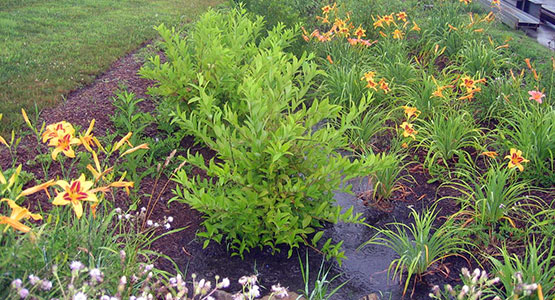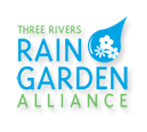Rain garden FAQs
Rain gardens are a big part of the answer to minimizing the negative environmental effects of storm water runoff. But before you decide to install one in your yard, you may have a few questions. Here are a few of the most common ones, along with answers.
- How much does a rain garden cost?
- Is a rain garden a pond?
- How much maintenance is required?
- Won't it attract mosquitoes?
- Do I have to use native plants?
- What about winter?
- Can it be too large or too small?
- Can I install myself?

How much does a rain garden cost?
Rain gardens cost about the same as other perennial flower gardens, and are less expensive than replanting annuals every year. The Calculator on this site will help you come up with an estimate, but the short story is that do-it-yourselfers can put in a garden for $3–5/square foot. Use a landscaper to plan and install, and you're looking at $10–15/square foot or more. Plants are the single most expensive item.
Is a rain garden a pond?
Rain gardens are designed to hold water for no more than 24-48 hours. Unlike ponds, you don't need costly pumps, electricity, or filters. In fact, a rain garden is a filter for the water that runs off of your property's impervious surfaces.
How much maintenance is required?
Less than a regular garden, if you use native plants. They adapt well to their natural surroundings, and don't need fertilizers or pesticides. While your natives are establishing their roots, water them every other day or so for two to three weeks, or until you see that they're thriving. After that, you'll never need to water them except during a prolonged dry spell.
Won't it attract mosquitoes?
Properly installed, your rain garden shouldn't hold water long enough for mosquito larvae to complete their 7-to-12-day life cycle. Rain gardens also attract dragonflies, who find mosquitoes quite tasty.
Do I have to use native plants?
You don't have to use plants native to Western Pennsylvania, but there are many advantages. Natives have adapted to our climate and are much better at handling the periodic inundation (getting their feet wet) that goes along with a rain garden. They'll also save you the time and money of replanting every year, and offer much greater wildlife value.
What about winter?
Even though your plants will be dormant, in the winter gardens can still help slow down water movement and enable it to be absorbed into the ground. Water may remain longer, particularly when the ground is frozen, but that's not a problem in winter.
Can it be too large or too small?
Using the Calculator on this website, or with the help of a landscaper or other professional, you can size your garden to handle all the rain that normally falls here. You don't have to plan gardens to capture all of the rain water from your house. For example, capturing water from a single downspout will help.
Can I install one myself?
Although it may take a little more digging to create the depression, rain gardens are no harder to install than a traditional perennial garden. If you need some help or just a little encouragement, check out the Resource page and Partners page.
